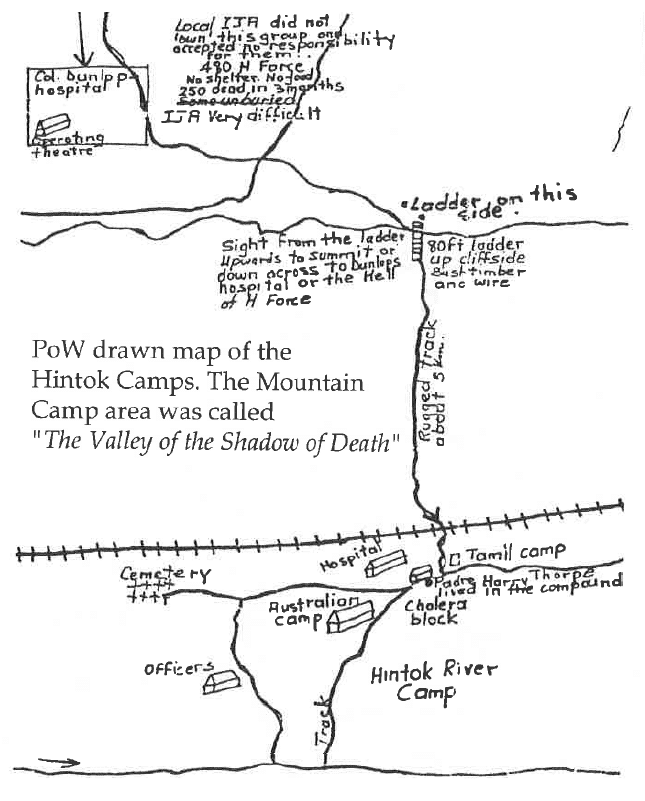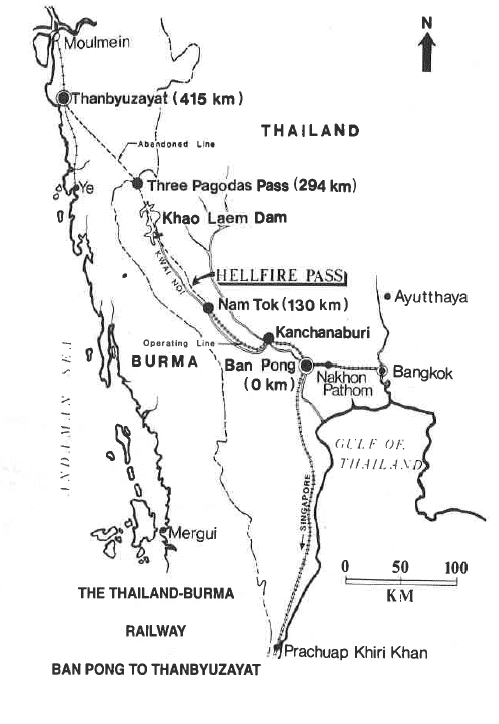
Sketch by John W. Wisecup of burial detail, Hintok, Thailand. Courtesy of the Oral History Program, University of North Texas. In Hell Under the Rising Sun (2008).
John Wisecup was captured on Java after the sinking of his ship, the heavy cruiser USS HOUSTON, on 1st March 1942. The HOUSTON in company with the Australian light cruiser HMAS PERTH was attempting a night passage of the Sunda Straits, between Sumatra and Java, when the ships sailed into a Japanese battle fleet landing troops on Java.
John, a Marine during his war service, was sent to Thailand as a member of ‘H’ Force in April 1943. This force was broken into six groups, one of which was allocated to the Hintok section of the railway.
PoW drawn map of the Hintok Camps. The Mountain Camp area was called “The Valley of the Shadow of Death”

A number of factors contributed to the high death toll of this group of 600 men. They had already been living as prisoners of the Japanese for more than a year on poor rations. ‘H’ Force remained under the control of the Japanese Administration in Singapore. This meant that all matters concerning the force were dealt with in Singapore – 2,000 kilometres away.
Hintok Mountain Camp was situated in an elevated valley high above the railway construction site and about four kilometers from the nearest riverside supply point. The campsite was surrounded, on three sides, by hills and mountains so that in the wet season of 1943 the entire area flooded and turned into a disease-ridden quagmire.
The work done by the men at Hintok (including members of ‘D’ Force from Singapore, “Dunlop’ Force from Java and Timor and Dutch from Java) consisted of building several large trestle bridges, constructing a large earth embankment and excavating a number of rock cuttings.
With the completion of the railway in the Hintok section, late in July, the survivors were moved down to the Hintok, River Camp to await evacuation downriver to Kanchanaburi. Whilst there many more men died from the effects of the three months in the hell that was Hintok. Unfortunately, over the years most of John’s drawings have been lost or given away (he was a merchant seaman for many years) but equally fortunately the “USS Houston Survivors Association” persuaded him to produce a photocopy collection of these drawings before they disappeared. It has been my privilege to be given a copy of this collection and one of the now rare originals.
With John’s permission and blessing this book has now been produced so as to give today’s people a glimpse, both visual and descriptive, of life as a prisoner of the Japanese forced to slave on the Thailand-Burma Railway.

Foreword to collection compiled for “USS Houston Survivors Association”.
“In May of 1943 a group of prisoners of war, mostly British and Australian, left Changi prison in Singapore destined for the jungles of Thailand. Thirteen Americans were included in this group of unfortunates who would be forced to endure untold brutality, starvation and diseases while building a railroad trestle on the infamous Burma/Thailand Death Railroad.
One of those Americans, A U.S. Marine survivor of the sinking of the U.S.S. Houston named John Wisecup, gained a reputation as a ‘rugged, tough man’. Despite legs swollen by beri-beri, leg and foot tropical ulcers, dysentery and occasional bouts of malaria Wisecup not only refused to shirk his share of the slave labor but also entertained his fellow Americans with his wit and cartoons. After his return from the war Wisecup wrote a poem ” Saga of Bamboo Jack ”and sketched a series of drawings depicting his recollections of that “part of hell” that was called Hintok. Critizing his drawings as ‘cartoonish’ Wisecup did nothing with them other than to give a few to some friends and shipmates. We have finally persuaded him to share his drawings with all of us. Although Hintok was one of the worst, we feel that it represents all of the many atrocities committed upon helpless prisoners of war by the cruel Japanese and Koreans, and that Wisecup’s drawings are a gruesome reminder that we must never forget.”
Contiune Reading the Poem Saga of Bamboo Jack
